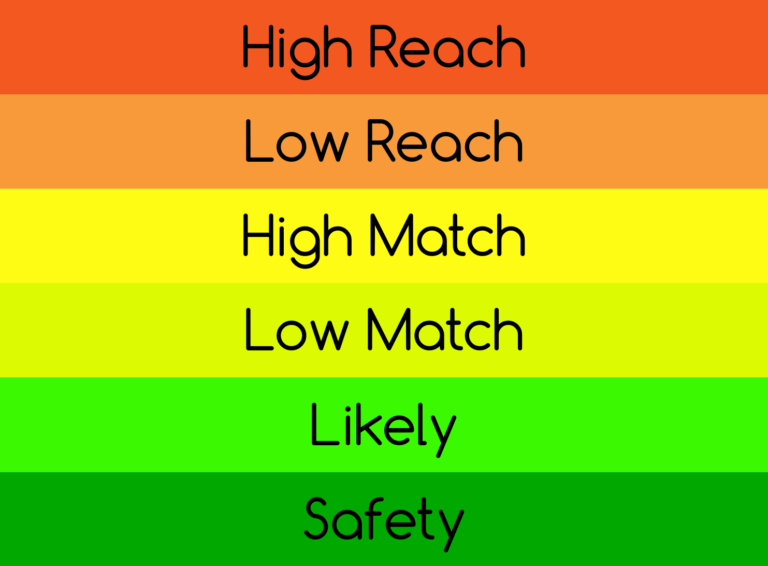
One of my key recommendations is that students should develop a strategy about applying early to college. Applying early to colleges provides the following advantages over applying purely Regular Decision.
- Good news early: Students who apply early often get offers of admission as early as December, or even earlier in the case of rolling admissions. It feels good to have some acceptances in the bag.
- Might be done early: Furthermore, if you get accepted to one your reach colleges, you might be completely done with college admissions by December.
- Early Decision advantage: If you apply “Early Decision”, you generally increase your odds of admission significantly compared to applying to the same college using Regular Decision.
- Can Save Money: If you get acceptances in December, you might be able to skip some colleges on your Regular Decision list, saving you application fees.
Be Ready to Apply
To get these advantages, you need to be fully ready to apply by the early application deadlines, which are typically November 1st, but could be even earlier for scholarship applications. This is another reason why you should have your college list finalized by the end of your junior year, so you can work on your essays over the summer.
The Different Types of Early Applications
Colleges that allow early applications may restrict where else you can apply early. The most common rule types are the following:
- Early Action (EA): This is the non-restrictive case, meaning that the college does not care where else you apply early. If you apply EA, you learn of the admission decision as early as mid-December. It can sometimes be later, but certainly much earlier than with Regular Decision (hereafter called RD). If admitted EA, you still have until May 1st to make your decision as to where to attend. Most public universities offer non-restrictive EA. A few private colleges offer this too, including MIT and UChicago.
- Single-Choice Early Action (SCEA): SCEA means that if you apply to that college early, you cannot apply to any other private college’s early program (whether EA, SCEA, or Early Decision). However, you are generally allowed to apply to any public college’s early program. Colleges that practice SCEA are Harvard, Princeton, Yale, CalTech, and Stanford (although the last two call it Restrictive Early Action, or REA). The college will let you know of your admission status by mid-December, but if you are accepted, you still have until May 1st to decide to attend.
- Early Decision (ED): ED is a binding admission process to a single college, which then requires you to attend if they accept you. You are not allowed to apply ED anywhere else, but are generally allowed to apply to a non-restrictive EA program. The pros and cons of ED are described later.
- Early Decision 2 (ED2): ED2 has all the same rules of ED, but it typically has a deadline of Jan 1 (i.e. the same date that RD apps are due) and decisions come back in mid-February. The purpose of ED2 is that if you don’t get good news with your EA/SCEA/ED application, you get a second chance to apply and get the admission benefits of Early Decision.
- Rolling Admission (RA): Strictly speaking this is not an early application. However, you can apply and sometimes get back a decision as early as October. Examples of colleges that support rolling admissions include the University of Pittsburg and Michigan State.
Early Application Scenarios
The various early options are a lot to digest, so I will use examples to show what is possible. Let’s suppose a student is interested in the following nine colleges: Brown, Harvard, MIT, Michigan, Pittsburgh, UIUC, UT-Austin, UChicago and Vanderbilt. Note that both UChicago and Vanderbilt support both ED and ED2 and therefore appear in multiple scenarios. UChicago also supports EA as well.
- All scenarios: Apply rolling to Pittsburg, and EA to Michigan, UIUC and UT-Austin
- ED Scenario: ED Brown, ED2 Vanderbilt, RD to Harvard, MIT, UChicago
- EA Scenario: EA MIT, EA UChicago, ED2 Vanderbilt, RD to Harvard, MIT
- SCEA Scenario: EA Harvard, ED2 UChicago, RD to Brown, MIT, Vanderbilt
The key point about these scenarios is that it is possible for this student to apply anywhere from six to seven colleges early, leaving only two or three remaining for RD.
Should you apply Early Decision?
An important question that you have to decide is whether or not to apply ED?
You should treat that commitment to attend seriously. You should think of it as a binding contract that involves you, your parents, your high school, and the college you applied to. Breaking that contract can penalize future applicants from your high school applying to that college.
Pros of Early Decision
Applying ED can improve your chance of admission, sometimes quite significantly compared to the same student applying RD. This ED admission advantage applies to all students, including “unhooked”Applicants that do not benefit from "hooks". Examples of hoo... More students. Colleges offer this admission bump for ED students because it locks in students who both are excited about the college and meet the college’s academic criteria.
Cons of Early Decision
There are two possible cons to applying ED: Regret, and higher cost.
Students who are accepted ED are always initially elated. But they later may regret it if they applied ED to the “best college they thought they could get into”, rather than one of their top choices. They may wonder “What if I had applied to my top choices instead?” There is an easy solution to this: Don’t apply ED to a college unless it is one of your top choices.
The other con is possible higher cost. Students who are accepted ED into a highly selective college would very likely have been accepted to a number of other colleges. Some of these might have been more generous with financial aid or merit scholarships. There is also a solution to this: Don’t apply ED to a college unless your parents tell you it is affordable after they run the Net Price Calculator.
Where to Apply Early Decision
Ok, you have looked at the pros and cons, and think that ED makes sense for you. You are willing to commit somewhere in exchange for the admission bump. Where should you use this?
In terms of maximizing admission chances for reaches, your best bet is to apply ED to a college that you classified as a Low Reach (see post on classifying colleges using scattergrams). You can also apply ED to colleges classified as High Match or Low Match if you choose. I generally recommend against applying ED to a college that is a High Reach as that would most likely be wasting your ED admission bump.






